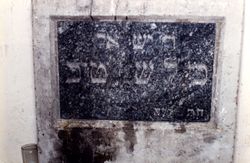بعل شم طوڤ
| بعل شم طوڤ | |
|---|---|
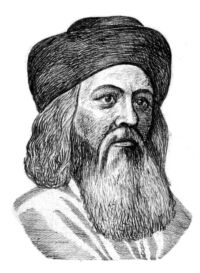 صورة ليست لبعل شم طوف، ولكنها شاعت أنها له. | |
| الاسم الكامل | ישראל בן אליעזר Yisroel ben Eliezer |
| التوقيع | |
| العمل الرئيسي | Keser Shem Tov Shivchei HaBesht |
| ولد | 18 أيلول 5458 (1698) Okopy Świętej Trójcy, Podolian Voivodeship, Kingdom of Poland |
| توفي | 6 سيڤان 5520 (1760) Medzhybizh, Podolian Voivodeship، مملكة پولندا |
| دفن | Medzhybizh |
| تبعه | Dov Ber of Mezritsh (1704-1772) |
| الأب | إلعازر |
| الأم | سارة |
| الزوجة | Chana |
| الأنجال | تسڤي من پينسك (1729-1779) أديل (1720-1787) |
الحاخام إسرائيل بن إلعازر (بالعبرية: רבי ישראל בן אליעזר; 18 أيلول 5458/1698- 6 Sivan 5520/1760)، ويسمى عادة بعل شم طوڤ ( /ˌbaːl ˈʃɛm ˌtʊv/ أو /ˌtʊf/) أو بشت، كان حاخام صوفي يهودي. ويعتبر مؤسس الحركة القاصدية.
أنقذت الحركة القاصدية اليهود الپولنديين بعض الإنقاذ من حالتهم الوضعية. وكان مؤسس "عقيدة التقوى" هذه إسرائيل بن ألعازر، المعروف باسم بعل شم-توب ("السيد الصالح لاسم الله")، واختصاراً باسم "بشت" الجامع لأول حروف اسمه الكامل. وكان يجوب البلاد معلماً للأطفال، وعاش في فقر تجمله البهجة، وكان يصلي بانتشاء ويشفي المرضى شفاء "معجزياً" بالأعشاب الجبلية. وقد طلب إلى أتباعه ألا يعيروا طقوس المجمع والمعرفة التلمودية كبير اهتمام، وأن يقتربوا إلى الله رأساً في شركة متواضعة ولكنها حميمة، وأن يبصروا الله ويحبوه في شتى صور الطبيعة ومظاهرها، في الصخور والأشجار، وفي حالات اليسر والألم؛ وأمرهم بأن يستمتعوا بالحياة في الحاضر بدلاً من البكاء على خطايا الماضي وآلامه. وكانت أقواله المأثورة البسيطة أحياناً تشبه أقوال المسيح. "شكا بشت أن ابنه ترك الله، وسأله قائلاً: يا معلم، ماذا أصنع؟ وأجابه بشت: أحبه أكثر مما فعلت في أي وقت". [1]
السيرة
النشأة
Yisroel (Israel) was born to poor parents Eliezer and Sarah in a settlement near Okopy, Ternopil Oblast, a newly built fortress close to Kameniec in West Ukraine, where Zbruch connects with Dniester. Today, Okopy is a village in Chortkiv Raion (district) of Ternopil Oblast.
In 1703, Israel became an orphan, and was adopted by the Jewish community of Tluste (near Zalischyky). It is reported that, after the conclusion of his studies at the local cheder (Jewish elementary school), he would often wander into the fields and forests that surrounded the village. In 1710, he finished cheder and became an assistant to a melamed (instructor in cheder). In 1711 at the age of 13/14 he entered the "Chaburas Machane Yisroel", a group of hidden tzaddikim led by Rabbi Adam Baal Shem. Sometime in 1712 Israel became a shammash (sexton) of the local synagogue.
He was hired as a teacher's assistant in the cheders of the small villages through which they passed. He later related that he took great pleasure in accompanying the children to and from school, using this opportunity to recite prayers with them and tell them Torah stories. The Mezritcher Maggid, the Baal Shem Tov's successor, would later say, "If only we kissed a Torah scroll with the same love that my master [the Baal Shem Tov] kissed the children when he took them to cheder as a teacher's assistant!"[2]
According to Hasidic legend, the Baal Shem Tov would have visions in which the prophet Achiya Hashiloni would appear to him.[3] In 1716 the Baal Shem Tov married, but soon his wife died and he went on travelling throughout Eastern Galicia. After serving for a long time as a helper in various small communities of West Ukraine, he settled as a melamed at Tluste.
The Besht was introduced to Kabbalah by Rabbi Adam Baal Shem of Ropczyce (باليديشية: ראָפּשיץ) who was a disciple of Rabbi Yoel Baal Shem (I) of Zamość (باليديشية: זאמושטש), the successor of Rabbi Eliyahu Baal Shem of Worms (باليديشية: ורמיזא, ורמישא).[4]
The Besht became the leader of this movement at the age of 18.[5] Caring for the Jewish poor, the group of Tzadikim encouraged Jews to move to agrarian lifestyles as alternatives to the chronic poverty of city Jews. In continuation of this policy, they decided that they needed to look after the educational needs of the children living in small farm communities. If a suitable teacher could not be sourced they themselves would provide one, and therefore the Baal Shem Tov became a teacher's assistant. He later commented "The most joyous time in my life was teaching the small children how to say Modeh Ani, Shema Yisrael and Kametz Alef Ah".[6]
He was chosen by people conducting suits against each other to act as their arbitrator and mediator. His services were brought into frequent requisition because the Jews had their own civil courts in Poland. He is said to have made such an impression on Ephraim of Brody that the latter promised the Besht his daughter Chana in marriage. The man died, however, without telling his daughter of her betrothal; but when she heard of her father's wishes, she agreed to comply with them.[7]
After their marriage, the couple moved to a village in the Carpathians between Kuty and Kassowa,[7] where their only income was from his work digging clay and lime, which his wife delivered to surrounding villages. The couple had two children: Udl (born in 1720) and Zvi Hersh. A maternal great-grandson of Baal Shem Tov and his wife was Reb Nachman of Breslov whose paternal ancestry came from (according to Hasidic tradition), the Maharal's family descended patrilineally from the Babylonian Exilarchs (during the era of the geonim) and therefore also from the Davidic dynasty.[8]
تطوره كزعيم
The Besht later took a position as a shohet (ritual butcher) in Kshilowice, near Iaslowice, which he soon gave up in order to manage a village tavern that his brother-in-law bought for him. His first appearance in public was that of an ordinary Baal Shem, a faith-healer who wrote amulets and prescribed cures,[7][9][10] functioning as a type of shaman.[11][12]
After many trips in Podolia and Volhynia as a Baal Shem, Besht, considering his following large enough and his authority established, decided about 1740 to expound his teachings in the shtetl (Jewish village) of Medzhybizh and people, mostly from the spiritual elite, came to listen to him. Medzhybizh became the seat of the movement and of the Medzybizh Hasidic dynasty. His following gradually increased and with it the hostility of the Talmudists. The Besht was supported at the beginning of his career by two prominent Talmudists, the brothers Meïr (chief rabbi of Lemberg and later Ostroha, and author of Meir Netivim (a work of halachic responsa) and other works) and Isaac Dov Margalios. Later he won over recognized rabbinic authorities who became his disciples and attested to his scholarship. These include Rabbi Yaakov Yosef Hakohen, rabbi of Polnoy; Rabbi Dovid Halperin, rabbi of Ostroha; Rabbi Israel of Satinov, author of Tiferet Yisrael; Rabbi Yoseph Heilperin of Slosowitz; and Rabbi Dov Ber of Mezrich (AKA the Maggid of Mezritch). It is chiefly due to the latter that Besht's doctrines (though in an essentially altered form) were introduced into learned Jewish religious circles.[7]
Israel undertook journeys in which he is recorded as effecting cures and expelling demons and evil spirits (shedim). Later Hasidic tradition, however, downplayed the importance of these healing and magical practices, concentrating on his teachings, his charm, magnetism, and ecstatic personality.[13]
The "Agudas Ohalei Tzadikim"[14] organization (based in Israel) has restored many graves of Tzadikim (Ohelim) in Ukraine, including the Baal Shem Tov's. A guesthouse and synagogue are located next to the Ohel of Baal Shem Tov, and the Baal Shem Tov's synagogue in the village proper has been painstakingly restored. Both synagogues are used by the many visitors from all over the world.
الخلافات مع الفرانكيين ووفاته
The Besht took sides with the Talmudists in their disputes against the Frankists (Jacob Frank's cultist movement which regarded Frank as the Messiah, modelled after Sabbatai Zevi.) After the mass conversion of the Frankists, the Baal Shem Tov allegedly said that as long as a diseased limb is connected with the body, there is hope that it may be saved; but, once amputated, it is gone, and there is no hope.[15] It is alleged that he died out of grief that the Frankists left Judaism.[16]
He died in Medzhybizh,[7] which was part of Poland (today in the Khmelnytskyi Oblast, Ukraine).[17]
الذكرى
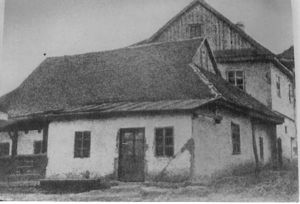
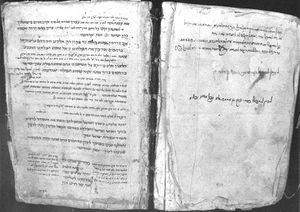
Israel ben Eliezer left no books; for the Kabbalistic commentary on Psalm 107, ascribed to him (Zhitomir, 1804), Sefer mi-Rabbi Yisrael Baal Shem-tov, may not be genuine. Therefore, the most reliable record of his teachings is in his utterances as recorded in the works of his disciples (Hasidim). Most are found in the works of Rabbi Jacob Joseph of Polnoy. But since Hasidism, immediately after the death of its founder, was divided into various parties, each claiming for itself the authority of Besht, the utmost of caution is necessary for judging as to the authenticity of utterances ascribed to Besht.[7]
Rabbi Jacob Joseph quotes over eight hundred teachings of his Master the Besht, in his books. In some rare quotes, Rabbi Jacob Joseph states that he's not sure if these particular quotes are the 'exact' words of the Baal Shem Tov. This seems to shows that all other quotes he repeats, are the 'exact words' he heard from his master. We therefore essentially have a full book of reliable authentic teachings of the Baal Shem Tov, relayed meticulously in the 'exact words' as heard directly from his mouth. This is the most powerful direct historical evidence of the Besht.
Some other direct historical evidence remains of the Besht during the days he lived in Medzhybizh. Rosman discovered numerous legal documents that shed light on this period from the Polish Czartoryski noble family archives. The Besht's house is mentioned on several tax registers where it is recorded as having tax-free status. Several of the Besht's colleagues in his stories from Shivhei HaBesht also appear in Polish court records, notably, Ze'ev Wolf Kitzes and Dovid Purkes. Rosman contends that the Polish documents show the Besht and his followers were not outcasts or pariahs, but rather a respected part of mainstream Jewish communal life.
Other direct evidence includes the Besht's daily prayer-book (siddur, owned by the Agudas Chabad Library in New York) with his handwritten personal notes in the margins. His grave can be seen today in the old Jewish cemetery in Medzhybizh.
Chapin and Weinstock contend that the Besht was essentially the right person, in the right place, at the right time. 18th century Podolia was an ideal place to foster a sea-change in Jewish thinking. It had been depopulated one generation earlier due to the Khmelnitsky Massacres. A Turkish occupation of Podolia occurred within the Besht's lifetime and along with it the influence within this frontier territory of Sabbatai Zevi and his latter day spiritual descendants such as Malach and Jacob Frank. Once the Polish Magnates regained control from the Turks, Podolia went through an economic boom. The Magnates were benevolent to the economic benefits the Jews provided, and encouraged Jewish resettlement to help protect the frontier from future invasions. Thus, the Jewish community itself was essentially starting over.
Practices
The Besht was a mystic who claimed to have achieved devekut ("adhesion"), meaning that his soul had reached the high level where he could "ascend" to heaven and speak with any soul in heaven that he wished to speak to (though his only recorded choice was of the Messiah, and only once), and intervene between humans and God. He had the ability to protect the Jewish community from plague and persecution.[18] He did this through prayer.
According to a letter from the Besht's brother-in-law to the Besht himself—as interpreted by Moshe Rosman— the latter was a practitioner of prophecy, being able to see a messianic figure arrive in Jerusalem despite living far from the city; the brother-in-law claims to have inquired into the figure and discovered the Besht's vision to be true. This claim also supports the supposed belief that the Besht had the ability to see the souls of men, divining the messianic quality of the man despite only seeing him through a vision. Rosman also describes another letter written by the brother-in-law which claims that the Besht could travel to heaven and commune with God. This view is derived from a series of titles given to the Besht, attributing various religious achievements to him such as understanding the mysteries of God. Similarly, Rosman—though now citing the writings of a Polish rabbi—says that it was believed the Besht was a great medical practitioner with vast knowledge regarding salves, balms, and similar medicants. Some aspects of his medical practice are said to have been mystic in nature, though the degree to which this is the case is not agreed upon. Some claimقالب:Like whom? that the Besht could only heal others through prayer and similar acts: recitation of holy words. In other works, he is said to have fewer limitations on his supposed ability, allowing for more mystic methods to be practised.[19]
He ate farfel every Friday night because the word was similar to the world farfalen which means "wiped out, over and finished". He considered the noodles a symbol marking the beginning of a new week.[20]
Core doctrines
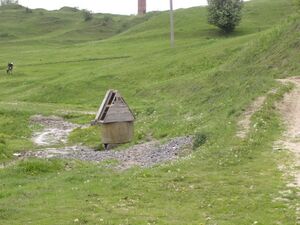
The Besht's concept of the zaddik is of the existence of superior individuals whose spiritual qualities are greater than those of other human beings and who are outstanding in their higher level of devekut. These individuals influence society, and their task is to teach the people to worship God by means of devekut and to lead sinners to repent.[21]
تأثيره على الحسيديم
الحسيديم في بولندة تناظر من بعض الوجوه حركات الإخوان الموابيين، والتقويين الألمان، والمثوديين الإنجليز؛ فقد اتفقت مع هذه الحركات على إخراج الدين من المعبد وإدخاله إلى القلب، ولكنها رفضت النسك والاكتئاب، وأمرت أتباعها بأن يرقصوا، ويستمتعوا بعناق أزواجهم، لا بل بالشراب بين الحين والحين إلى حد النشوة.
The later developments of Hasidism are unintelligible without consideration of Besht's opinion concerning man's proper relation with the universe. True worship of God consists of the cleaving to, and the unification with, God. To use his own words, "the ideal of man is to be a revelation himself, clearly to recognize himself as a manifestation of God." Mysticism, he said, is not the Kabbalah, which everyone may learn; but that sense of true oneness, which is usually as strange, unintelligible, and incomprehensible to mankind as dancing is to a dove. However, the man who is capable of this feeling is endowed with a genuine intuition, and it is the perception of such a man which is called prophecy, according to the degree of his insight. From this it results, in the first place, that the ideal man may lay claim to authority equal, in a certain sense, to the authority of the Prophets.[7] This focus on oneness and personal revelation help earn his mystical interpretation of Judaism the title of Panentheism.
A second and more important result of the doctrine is that through his oneness with God, man forms a connecting link between the Creator and creation. Thus, slightly modifying the Bible verse, Hab. JPS, Besht said, "The righteous can vivify by his faith." Besht's followers enlarged upon this idea and consistently deduced from it the source of divine mercy, of blessings, of life; and that therefore, if one loves him, one may partake of God's mercy.[7]
On the opposite side of the coin, the Baal Shem Tov warned the Hasidim:
- Amalek is still alive today … Every time you experience a worry or doubt about how God is running the world—that's Amalek launching an attack against your soul. We must wipe Amalek out of our hearts whenever—and wherever—he attacks so that we can serve God with complete joy.
It may be said of Hasidism that there is no other Jewish sect in which the founder is as important as his doctrines. Besht himself is still the real center for the Hasidim; his teachings have almost sunk into oblivion. As Schechter ("Studies in Judaism," p. 4) observes: "To the Hasidim, Baal-Shem [Besht] ... was the incarnation of a theory, and his whole life the revelation of a system."[7]
Teaching methods
Besht did not combat rabbinical Judaism, but the spirit of its practice. His teachings being the result of a deep, religious temperament, he stressed the spirit. Though he considered the Law to be holy and inviolable, and he emphasized the importance of Torah-study, he held that one's entire life should be a service of God.[7] Hasidic legend tells of a woman whom her relatives sought to kill on account of her shameful life, but who was saved in body and soul by Besht. The story is said to be characteristic of Besht's activity in healing those in need of relief. More important to him than prayer was a friendly relationship with sinners. Unselfishness and high-minded benevolence are a motif in the legends about him.[7]
Besht's methods of teaching differed from those of his opponents. He directed many satirical remarks at them, a characteristic one being his designation of the typical Talmudist of his day as "a man who through a sheer study of the Law has no time to think about God". Besht is reported to have illustrated his views of asceticism by the following parable:
- A thief once tried to break into a house, the owner of which, crying out, frightened the thief away. The same thief soon afterward broke into the house of a very strong man, who, on seeing him enter, kept quite still. When the thief had come near enough, the man caught him and put him in prison, thus depriving him of all opportunity to do further harm.[7]
Besht held a firm conviction that God had entrusted him with a special mission to spread his doctrines. He believed that he had heavenly visions revealing this mission to him. For him, every intuition was a divine revelation, and divine messages were daily occurrences.[7] An example of the power of his spiritual vision is found at the beginning of his grandson's work, Degel, where he writes that his grandfather wrote to Gershon Kitover who lived in Israel, asking him why he was not in Israel that particular Shabbos.
Legends
The world makes three errors by thinking that telling stories of the Baal Shem Tov on Motzei Shabbat ensures one’s livelihood. First of all, these stories are not to be limited to the Baal Shem Tov, but should include tales of all our Tzaddikim. Secondly, they should not be told only after but at any time. And lastly, telling these stories not only ensures livelihood, but serves as a Segulah to ensure we receive an abundance of blessings relating to our children, good health and success in our livelihood
— Maharash
In Hasidic tradition, there's a saying, "Someone who believes in all the stories of the Baal Shem Tov and the other mystics and holy men is a fool; someone who looks at any single story and says, 'That one could not be true' is a heretic."[22]
According to the Encyclopaedia Judaica the number of legends that are told relating to the Ba'al Shem Tov have 'distorted his historical character.'[21] An anthology of legends about him was first compiled by Dov Baer b. Samuel of Linits, who was the son-in-law of Alexander Shoḥat, who had acted for several years as the Besht's scribe. The collection was copied many times and over time it became filled with errors. It was printed with the title, Shivḥei ha-Besht after Dov Baer's death. It was published by Israel Jaffe who rewrote the first chapter and removed what he considered to be the distortions caused by copyists.
This edition, printed in Kopys (Kapust) in 1814, contains 230 stories grouped by common themes, characters, and motifs. Two editions also appeared in Yiddish that differ markedly from the Hebrew edition.
In the 19th century several further collections of legends about the Ba’al Shem Tov, and his followers appeared, in Hebrew and Yiddish, some of which repeated stories found in Shivḥei ha-Besht and some of which contained new stories. According to the Encyclopaedia Judaica only a few of these stories can actually be regarded as true.[23]
One legend tells that his father, Eliezer, was seized during an attack, carried from his home in Wallachia, and sold as a slave to a prince. On account of his wisdom, he found favor with the prince, who gave him to the king to be his minister. During an expedition undertaken by the king, when other counsel failed, and all were disheartened, Eliezer's advice was accepted; and the result was a successful battle of decisive importance. Eliezer was made a general and afterward prime minister, and the king gave him the daughter of the viceroy in marriage. But being mindful of his duty as a Jew and as he was already married, he married the princess only in name. After being questioned for a long time as to his strange conduct, he confessed to the princess that he was a Jew, who loaded him with costly presents and helped him escape to his own country.[7]
On the way, the prophet Elijah is said to have appeared to Eliezer and said: "On account of thy piety and steadfastness, thou wilt have a son who will lighten the eyes of all Israel; and Israel shall be his name because in him shall be fulfilled the verse (Isaiah JPS): 'Thou art my servant, O Israel, in whom I will be glorified.'" Eliezer and his wife Sarah, however, reached old age childless and had given up all hope of ever having a child. But when they were nearly a hundred years old, the promised son (Besht) was born.[7]
أبرز تلاميذه
The Baal Shem Tov directly imparted his teachings to his students, some of whom founded their own Hasidic dynasties.
- Yaakov Yosef of Polonoy (1710–1784)
- Ze'ev Wolf Kitzes of Medzhybizh (~1685–1788)
- Yechiel Michel of Zlotchov (1721–1786)
- Dov Ber of Mezeritch (1704–1772) traced to King David by way of Rabbi Yohanan, the sandal-maker and master in the Talmud
- Pinchas of Korets (1728–1790)
- Nachum Twerski of Chernobyl (1730–1797) founder of the Chernobyl Hasidic dynasty
- Leib of Shpola (1725–1812)
- Rabbi Abraham Gershon of Kitov (Kuty), brother-in-law of The Baal Shem Tov (1701–1761); descendant (possibly the grandson) of Shabbatai ha-Kohen ("the ShACh") (1625–1663)
- Moshe Chaim Ephraim of Sudilkov (1748–1800) (his grandson)
- Boruch of Medzhybizh (1753–1811) (his grandson)
- Meir Hagadol of Premishlan (1703–1773)
- Nachman of Horodenka (d. 1765)
اللبس مع بعل شم من لندن
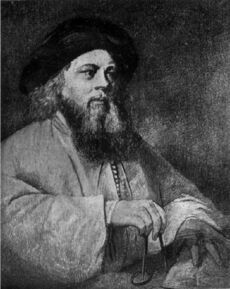
A portrait by John Singleton Copley often mistaken for the Baal Shem Tov is really a portrait of Hayyim Samuel Jacob Falk, who was known as the Baal Shem of London.[24]
في الثقافة الشعبية
In 2019, the American funk quartet The Fearless Flyers released an instrumental single named "The Baal Shem Tov" in honor of the rabbi.[25][26]
Singer Matisyahu's song Baal Shem Tov on the album Spark Seeker is named after him.
He was portrayed by Luzer Twersky in the Ukrainian film Dovbush (2023).
وفاته وأثره
فلما مات بعل شم-توب عام 1760 تولى رعاية قطيعه، وأحياناً جز صوفه،(43) سلسلة من "الصديقين". وحارب التلموديين السنيون بزعامة عالم متعصب من فلنا يدعى إيليا بن سليمان "القاصدين" بالنصح والحرم، ولكن عددهم زاد بانهيار پولندا (1772-92)، ولم يختتم القرن حتى كانوا يعدون 100.000 نسمة.
انظر أيضاً
- قائمة الأسرات القاصدية
- اليهودية الحسيدية
- تاريخ اليهود في برودي
- Hasidim and Mitnagdim
- بعل شم
- ربه
- Tzavaat HaRivash
الهامش
- ^ ديورانت, ول; ديورانت, أرييل. قصة الحضارة. ترجمة بقيادة زكي نجيب محمود.
- ^ Hayom Yom, Tammuz 16.
- ^ Golding, Peretz. "The Baal Shem Tov—A Brief Biography – Jewish History". Chabad.org. Retrieved 2013-03-12.
- ^ "לקוטי דבורים – חלק ג – שניאורסון, יוסף יצחק, 1880–1950 (page 39 of 405)". hebrewbooks.org. Retrieved 2014-02-10.
- ^ "לקוטי דבורים - חלק ג - שניאורסון, יוסף יצחק, 1880-1950 (Page 42 of 405)". Archived from the original on 2014-02-17. Retrieved 2014-02-17.
- ^ "לקוטי דבורים - חלק ג - שניאורסון, יוסף יצחק, 1880-1950 (Page 43 of 405)". Archived from the original on 2014-02-17. Retrieved 2014-02-17.
- ^ أ ب ت ث ج ح خ د ذ ر ز س ش ص ض
 One or more of the preceding sentences incorporates text from a publication now in the public domain: Singer, Isidore; et al., eds. (1901–1906). "BA'AL SHEM-ṬOB, ISRAEL B. ELIEZER". The Jewish Encyclopedia. New York: Funk & Wagnalls.
One or more of the preceding sentences incorporates text from a publication now in the public domain: Singer, Isidore; et al., eds. (1901–1906). "BA'AL SHEM-ṬOB, ISRAEL B. ELIEZER". The Jewish Encyclopedia. New York: Funk & Wagnalls. {{cite encyclopedia}}: Invalid|ref=harv(help) - ^ See The Maharal of Prague's Descent from King David, by Chaim Freedman, published in Avotaynu Vol 22 No 1, Spring 2006
- ^ John M. Efron, Medicine and the German Jews: A History, Yale University Press, p. 91:
"Israel ben Eliezer Baal Shem-Tov (1700–1760), the founder of Hasidism, was in fact a faith healer and amulet writer" - ^ https://www.worldhistory.org/Kabbalah/
"Hasidism or Hasidic Judaism was ostensibly founded by an 18th-century CE itinerant mystic and faith-healer who came to be called the Baal Shem Tov" - ^ YIVO Encyclopedia: https://yivoencyclopedia.org/article.aspx/baal_shem_tov:
"(Yisra’el ben Eli‘ezer, 'the Besht'; ca. 1700–1760), healer, miracle worker, and religious mystic... founder of the modern Hasidic movement... in the 1730s, Yisra’el began using the title ba‘al shem or ba‘al shem tov (... meaning that he was a 'master of God’s name,' which he could manipulate for theurgic purposes), denoting his skills as a healer—one Polish source refers to him as ba‘al shem doctor—and his general qualifications as a shaman, a figure who could mediate between this world and the divine spheres in an effort to help people solve their... problems." - ^ https://www.tabletmag.com/sections/news/articles/psychedelic-summit-madison-margolin: "The Baal Shem Tov, himself, the father of the Hasidic movement, was said to be a medicine man, an herbalist, and shaman of sorts, who would go around with his enchanted pipe, providing healing to people."
- ^ ENCYCLOPAEDIA JUDAICA, Second Edition, Volume 10, p. 744, Haim Hillel Ben-Sasson]
- ^ "OHALEI TZADIKIM- About Us". Archived from the original on 2009-04-30. Retrieved 2009-09-06.
- ^ The Besht: Magician, Mystic, and Leader, Immanuel Etke, UPNE, 2012 - Biography & Autobiography, p. 95
- ^ Macijeko, Pawel (2011). The Mixed Multitude.
- ^ "Medzhybizh". Wumag.kiev.ua. Archived from the original on 2008-10-08. Retrieved 2013-03-27.
- ^ Comparative Perspectives on Judaisms and Jewish Identities, Stephen Sharot, Wayne State University Press, 2011, p. 59
- ^ Jay., Rosman, Murray (1996). Founder of Hasidism: a quest for the historical Ba'al Shem Tov. Berkeley: University of California Press. ISBN 9780520916760. OCLC 44962956.
{{cite book}}: CS1 maint: multiple names: authors list (link) - ^ Jewish Soul Food: Traditional Fare and What it Means, Carol Ungar, Brandeis University Press, 2005, p. 25
- ^ أ ب ENCYCLOPAEDIA JUDAICA, Second Edition, Volume 10, p. 746, Avraham Rubinstein
- ^ "Meaningful Life Center". Meaningfullife.com. 2000-07-23. Archived from the original on 2009-07-06. Retrieved 2009-05-05.
- ^ ENCYCLOPAEDIA JUDAICA, Second Edition, Volume 10, p. 747, Avraham Rubinstein
- ^ "Ba'al Shem Tov". tovste.info. Retrieved October 28, 2014;
"The Ba'al ShemTov". onthemainline. March 15, 2006. Retrieved October 28, 2014. - ^ The Fearless Flyers. "The Baal Shem Tov". YouTube. Vulf Records. Retrieved 26 April 2019.
- ^ Deflin, Kendall (25 April 2019). "The Fearless Flyers Release New Single, "The Baal Shem Tov" Featuring Joey Dosik". Live for Live Music. L4LM. Retrieved 26 April 2019.
وصلات خارجية
- The Baal Shem Tov Foundation
- Brief biography
- Tzava’at Harivash — The Testament of Rabbi Israel Baal Shem Tov translated to English
- Baal Shem Tov minisite on chabad.org
- Map of the Baal Shem Tov and his disciple’s travels from Routledge Publishing
- Thirty Six Aphorisms of the Baal Shem Tov
- Jewish Encyclopedia article
- Video Lecture on the Ba'al Shem Tov by Dr. Henry Abramson
- History of Jewish Community in Medzhibozh
قصص بعل شم طوڤ
- Chassid Stories Archive
- Baal Shem Tov Foundation Story Room
- Hasidic Stories — Besht
- Baal Shem Tov Foundation — Library
خطأ لوا في وحدة:Authority_control على السطر 278: attempt to call field '_showMessage' (a nil value).
- Wikipedia articles incorporating a citation from the 1906 Jewish Encyclopedia
- Wikipedia articles incorporating a citation from the 1906 Jewish Encyclopedia without a Wikisource reference
- Wikipedia articles incorporating text from the 1906 Jewish Encyclopedia
- Articles containing عبرية-language text
- Articles with hatnote templates targeting a nonexistent page
- Articles containing يديشية-language text
- Pages with empty portal template
- بعل شم طوڤ
- مواليد 1698
- وفيات 1760
- People from Borshchiv Raion
- Early Acharonim
- حاخامات القرن 18
- حاخامات قاصديون
- التاريخ اليهودي الاوكراني
- People from Medzhybizh
- Panentheists
- قباليون
- حاخامات أصبح ضريحهم أماكن للحج
- حاخامات أرثوذكس اوكرانيون
- حاخامات أرثوذكس پولنديون
- حاخامات قاصديون في اوروبا



